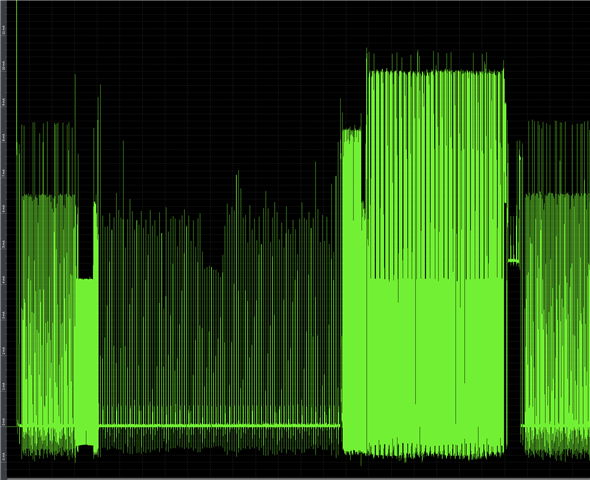I continue to successfully upload the Blinkey app via DFU. However, when I attempt to upload my development app it does not start. From what I read it has successfully loaded the app.
I'm not sure I fully understand the RTT readout - Could it be related to the starting address? If so, how can that be properly determined and modified in the code.
Otherwise, assistance pointing me in the right direction would be appreciated.
DFU Setup Specifics:
- Bootloader Application: SDK16.0\examples\dfu\secure_bootloader\pca10040_s132_ble_debug
- nRF52 DK (nRF52832)
- Segger IDE / Windows 10
- nRF Connect Windows10 - used for DFU zip file transfer
Short output from RTT file. End of DFU and output after restart of nrf52DK:
................. (Started at the end of the file - full file is attached)
<debug> nrf_dfu_ble: Buffer 0x200083A4 acquired, len 60 (244) <debug> nrf_dfu_req_handler: Handle NRF_DFU_OP_OBJECT_WRITE (data) <debug> nrf_dfu_flash: nrf_fstorage_write(addr=0x000682DC, src=0x200083A4, len=60 bytes), queue usage: 1 <debug> nrf_dfu_req_handler: Request handling complete. Result: 0x1 <debug> nrf_dfu_flash: Flash write success: addr=0x000682DC, pending 1 <debug> nrf_dfu_ble: Freeing buffer 0x200083A4 <debug> nrf_dfu_req_handler: Handle NRF_DFU_OP_CRC_GET (data) <debug> nrf_dfu_req_handler: Offset:271128, CRC:0x012B49C3 <debug> nrf_dfu_req_handler: Request handling complete. Result: 0x1 <debug> nrf_dfu_req_handler: Handle NRF_DFU_OP_OBJECT_EXECUTE (data) <debug> nrf_dfu_req_handler: Whole firmware image received. Postvalidating. <debug> nrf_dfu_validation: Hash verification. start address: 0x26000, size: 0x42318 <debug> nrf_dfu_validation: Invalidating old application in bank 0. <debug> nrf_dfu_settings: Writing settings... <debug> nrf_dfu_settings: Erasing old settings at: 0x0007F000 <debug> nrf_dfu_flash: nrf_fstorage_erase(addr=0x0x0007F000, len=1 pages), queue usage: 1 <debug> nrf_dfu_flash: nrf_fstorage_write(addr=0x0007F000, src=0x2000934C, len=896 bytes), queue usage: 2 <info> nrf_dfu_settings: Backing up settings page to address 0x7E000. <debug> nrf_dfu_settings: Writing settings... <debug> nrf_dfu_settings: Erasing old settings at: 0x0007E000 <debug> nrf_dfu_flash: nrf_fstorage_erase(addr=0x0x0007E000, len=1 pages), queue usage: 3 <debug> nrf_dfu_flash: nrf_fstorage_write(addr=0x0007E000, src=0x200096CC, len=896 bytes), queue usage: 4 <debug> nrf_dfu_req_handler: Request handling complete. Result: 0x1 <debug> app: timer_stop (0x20005984) <debug> app: timer_activate (0x20005984) <debug> nrf_dfu_flash: Flash erase success: addr=0x0007F000, pending 4 <debug> nrf_dfu_flash: Flash write success: addr=0x0007F000, pending 3 <debug> nrf_dfu_flash: Flash erase success: addr=0x0007E000, pending 2 <debug> nrf_dfu_flash: Flash write s<info> app: Inside main <debug> app: In nrf_bootloader_init <debug> nrf_dfu_settings: Calling nrf_dfu_settings_init()... <info> app: Inside main <debug> app: In nrf_bootloader_init <debug> nrf_dfu_settings: Calling nrf_dfu_settings_init()... <debug> nrf_dfu_flash: Initializing nrf_fstorage_nvmc backend. <debug> nrf_dfu_settings: Using settings page. <debug> nrf_dfu_settings: Copying forbidden parts from backup page. <debug> nrf_dfu_settings: Destination settings are identical to source, write not needed. Skipping. <info> nrf_dfu_settings: Backing up settings page to address 0x7E000. <debug> nrf_dfu_settings: Destination settings are identical to source, write not needed. Skipping. <debug> app: Enter nrf_bootloader_fw_activate <info> app: No firmware to activate. <debug> app: App is valid <debug> nrf_dfu_settings_svci: Erasing settings page additional data. <info> nrf_dfu_settings: Backing up settings page to address 0x7E000. <debug> nrf_dfu_settings: Writing settings... <debug> nrf_dfu_settings: Erasing old settings at: 0x0007E000 <debug> nrf_dfu_flash: nrf_fstorage_erase(addr=0x0x0007E000, len=1 pages), queue usage: 0 <debug> nrf_dfu_flash: Flash erase success: addr=0x0007E000, pending 0 <debug> nrf_dfu_flash: nrf_fstorage_write(addr=0x0007E000, src=0x200096CC, len=896 bytes), queue usage: 1 <debug> nrf_dfu_flash: Flash write success: addr=0x0007E000, pending 0 <debug> app: Running nrf_bootloader_app_start with address: 0x00001000 <debug> app: Disabling interrupts. NVIC->ICER[0]: 0x0 ///////////////////////////////////////////////// // Power Down and back up - // 00> <info> app: Inside main 00> <debug> app: In nrf_bootloader_init 00> <debug> nrf_dfu_settings: Calling nrf_dfu_settings_init()... 00> <debug> nrf_dfu_flash: Initializing nrf_fstorage_nvmc backend. 00> <debug> nrf_dfu_settings: Using settings page. 00> <debug> nrf_dfu_settings: Copying forbidden parts from backup page. 00> <debug> nrf_dfu_settings: Destination settings are identical to source, write not needed. Skipping. 00> <info> nrf_dfu_settings: Backing up settings page to address 0x7E000. 00> <debug> nrf_dfu_settings: Destination settings are identical to source, write not needed. Skipping. 00> <debug> app: Enter nrf_bootloader_fw_activate 00> <info> app: No firmware to activate. 00> <debug> app: App is valid 00> <info> nrf_dfu_settings: Backing up settings page to address 0x7E000. 00> <debug> nrf_dfu_settings: Destination settings are identical to source, write not needed. Skipping. 00> <debug> app: Running nrf_bootloader_app_start with address: 0x00001000 00> <debug> app: Disabling interrupts. NVIC->ICER[0]: 0x0
Thank you to Hung Bui who help me out on a previous question.
Regards,
Peter


